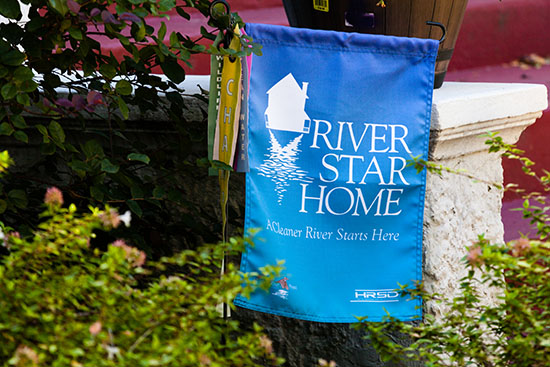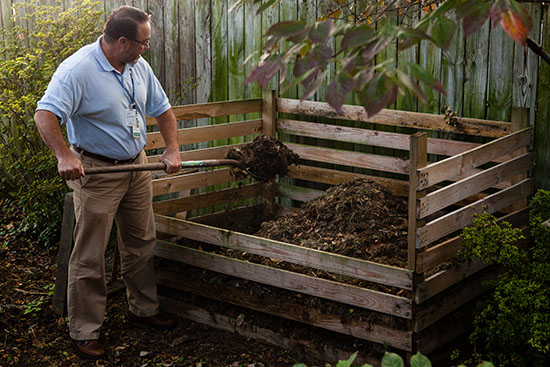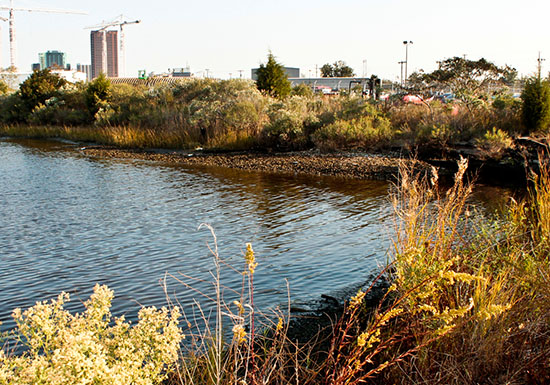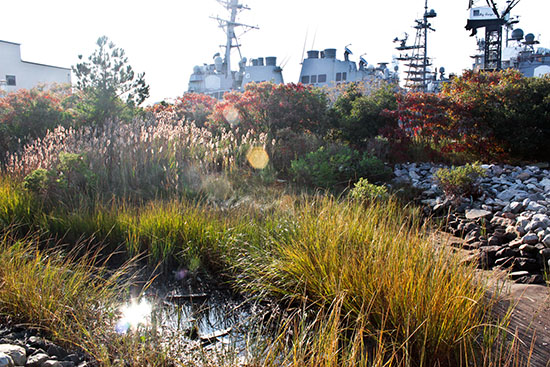Small water quality pledges turn into big motivation for homes and businesses
River Star programs get homes and businesses to take the next step

Let’s say you’re a homeowner in Norfolk, Virginia, and a storm rolls in. As the rain falls on your yard you realize that you haven’t cleaned up after your dog. You’re tempted to forget it and stay dry. Then, through your water-streaked window you see your River Star Home flag flapping furiously in the wind, and you remember that “scoop the dog poop” is at the very top of the list of seven River Star guidelines you agreed to. You grab a raincoat and a shovel.
It’s no accident that the flag—and the pledge it represents—seems to hold a certain power for the nearly 3,200 people who have signed up for Elizabeth River Project’s (ERP) River Star Homes.
Any homeowner can sign up to join the River Star Homes program. Participants commit to do seven simple things to help improve water quality and restore the Elizabeth River.

“There are studies that show you're more likely to carry out those behaviors because everybody knows that you made that pledge,” says Marjorie Mayfield Jackson, ERP’s executive director.
With funding from a National Fish and Wildlife Foundation grant, Jackson and her staff participated in workshops with social marketing expert Doug McKenzie-Mohr. She says the River Star Program incorporates some of the ideas from those sessions—with ERP’s own spin on them. The idea for the flag came from another marketing professional who wanted something classy that people would want to display.
“We've actually been mimicked now,” Jackson says. “But ours was the first.”
That makes homeowner Tim Ferring one of the first of the first. He signed up soon after the program launched in 2011.
“The River Star flags started popping up all over the place, and you weren’t cool unless you had one,” Ferring says, jokingly.

Walking around his suburban property with River Star Homes program manager Sara Felker and grassroots coordinator Casey Shaw, Ferring passes his rain barrel and his sizeable compost pile and steps over the low-lying native plants that mark his rain garden. Since installing the rain garden, Ferring says his basement doesn’t leak and he doesn’t have to use a sump pump.
Jackson says another lesson that helped shape River Star Homes is that once someone agrees to something small, they are more likely to take the next step.
“And then we come back and then we ask them to consider things that are more costly and actually require them to do stuff on the ground,” Jackson says. “And we have a really good response.”
Ferring, for one, talks wistfully of installing a cistern so that he can water his lawn entirely with rainwater. As she leaves, Felker promises to email him information on solar power.

ERP also runs River Star Schools and River Star Businesses. Predating River Star Homes, River Star Businesses is a program that BAE Systems Norfolk Ship Repair joined in 1998. Just two years later, the shipyard achieved model level, River Star Business’s highest recognition of accomplishments in pollution prevention and wildlife habitat.
“They were pioneers in everything—capturing the runoff, doing the [treatment for] tributyltin, oyster reefs, habitat,” says Pam Boatwright, River Star Businesses program manager.
Mike Ewing, BAE Systems’ environmental programs manager, recalls when all they had to do was put straw bales down the dock to keep trash out of the river. When the copper-based paint used on ships would be blasted off, it would stain the water a blood red and flow out into the river.
“Probably one of the biggest things we were ever been able to accomplish was convincing them that they needed to spend several hundred thousand dollars to build these troughs around the end of the dry dock to collect runoff from the docks,” Ewing says. “And then we would treat it.”
Boatwright points out that the move was voluntary, not regulatory.
In addition to treating roughly 10 million gallons of wastewater every year, including about 9 million gallons from the dry docks, BAE Systems saves another million gallons of water by reusing steam condensate in their boilers. Other initiatives include the reuse of 50,000 gallons of recovered oil, the recycling of eight million pounds of materials, and the raising of 15,000 oyster spat every year. Ewing estimates their current move to LED lighting will save about 1.5 to 2 million kWh per year.
Ewing credits new ownership, a culture shift at the shipyard, and some pushing by himself and his colleague Steve Bulleigh for the striking changes.
The relationship with ERP, however, began with Ewing’s predecessor, who first reached out for help building a little wetland.

“He was trying to make small steps,” Boatwright says. “We made it really easy in the beginning to build trust and get people into the fold.”
The relationship between ERP and BAE Systems is now approaching two decades. Over the years, Boatwright says she has done a lot of cheerleading, as well as helping BAE Systems to identify and then support those projects.
“I think once we got the ball rolling it got better,” Ewing says. “And it got easier to do. And we've been lucky.”
Ewing says BAE Systems has won about 30 awards since 2000, including the Virginia Governor's Environmental Excellence Gold Award, without ever experiencing a lot of serious pushback from the company about rolling out new environmental programs.
“There's a lot of resistance to change,” Ewing says. “But most of these guys, they're campers and fisherman and they swim and they boat. And they like the water and they’re hunters. And so they really want to do the right thing.”
To view more photos, visit the Chesapeake Bay Program’s Flickr page
Photos and text by Will Parson
Additional photos courtesy Ed Ketz/BAE Systems

Comments
There are no comments.
Thank you!
Your comment has been received. Before it can be published, the comment will be reviewed by our team to ensure it adheres with our rules of engagement.
Back to recent stories